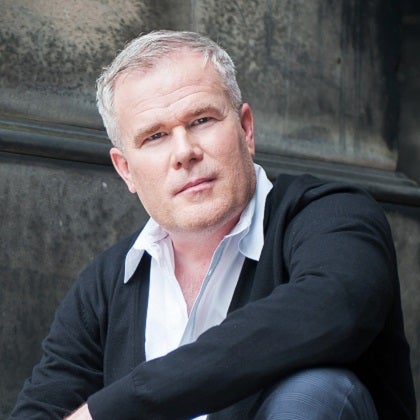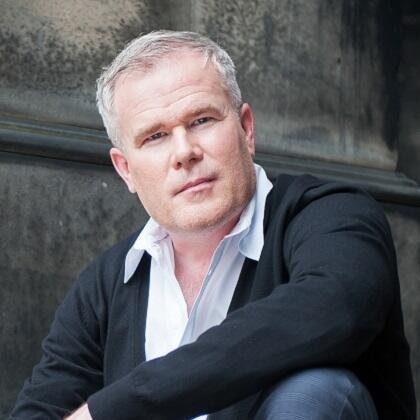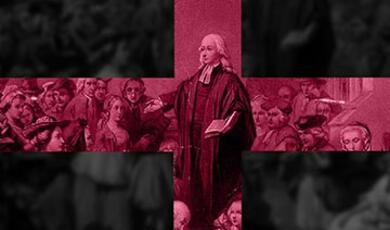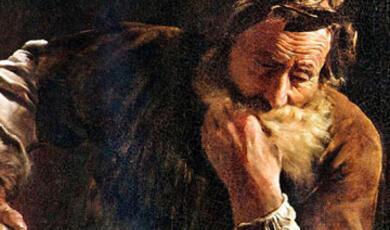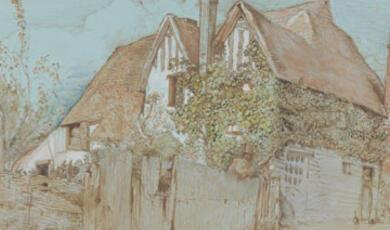Picturesque Engineering: Telford's Highland Roads and Bridges
Share
- Details
- Text
- Audio
- Downloads
- Extra Reading
In partnership with the Fulbright Commission.
In 1819, Thomas Telford and Robert Southey went on a six-week tour of the Scottish Highlands to inspect the region’s newly built roads, bridges and canals. What compelled this unlikely duo, the “Colossus of Roads” and Britain’s Poet Laureate, to undertake one of the greatest road trips of the Picturesque era?
Landscape historian and Fulbright scholar Paul Daniel Marriott explores the legacy of their extraordinary journey, meticulously chronicled by Southey, on travel, transport and design in the twenty-first century.
Download Text
Picturesque Engineering: Telford’s Highland Roads and Bridges
Professor Paul Marriott
14th March 2023
Introduction
In 1819, for a period of exactly six weeks, Thomas Telford, the distinguished civil engineer and Robert Southey, the Poet Laureate of Great Britain, went on a tour of the Scottish Highlands to inspect the construction of Telford’s roads, bridges and canals. The projects were part of a massive government-sponsored public works program to slow the depopulation of the Highlands by providing modern infrastructure to support communication, commerce and travel. Despite the official charge for the travel, their tour and itinerary were not unlike those of the many thousands who were seeking out the picturesque landscapes in the Highlands and other popular destinations in Britain recognized for their bold scenery. What distinguished their tour was the preeminence of the two men and Southey’s meticulous journal chronicling the trip. Their sojourn into the Highlands personified the union of technology with the landscape and embodied the fertile intellectual climate of the Picturesque era. Southey’s journal of the tour was published posthumously as Journal of a Tour in Scotland in 1929.
The tour was probably planned by John Rickman, Secretary of the Commissioners for the Caledonian Canal, and a mutual friend to both men. The engineer and the poet had not formally met until being introduced in Edinburgh a few days before the tour began on Tuesday, 17 August 1819. Southey described meeting Telford in his Journal noting, “There is so much intelligence in his countenance, so much frankness, kindness and hilarity about him, flowing from the never-failing well-spring of a happy nature, that I was upon cordial terms with him in five minutes.”[1] In the 1929 Introduction to Southey’s Journal, C. H. Herford noted that, “no ordinary tourist in quest (as it was then the fashion to be) of the ‘picturesque’ would have described so indefatigably as he, the canals, roads, bridges, docks and harbours they pass.”[2]
Picturesque Engineering
The Journal is an important account demonstrating the intersection between the science of modern road-making and the picturesque landscape. While the Journal was not published until 1929, and therefore cannot be suggested as a direct influence on the design of scenic roads constructed in the nineteenth or early twentieth centuries, it nonetheless captured a valuable intersection of art and science through the pairing of Britain’s Poet Laureate with the “Colossus of Roads,” and provides a fastidious record of the interest in roads within the picturesque landscape during this period. The stature of both men in their respective fields suggests that Southey’s commentary over the six-week tour represents both a highly articulate account of the Picturesque applied to the modern road, and a technically competent report on the state-of-the-art of road-making and construction at this time.
From the detailed accounts of engineering techniques, surveying and construction practices presented, Southey appeared to be an eager and competent student under the tutelage of the great engineer. His descriptions became more detailed and technical as the tour progressed, and his layman’s explanations provide a valuable insight into the engineering practices of the day that the more perfunctory technical reports of the period did not always articulate well. As a proponent of the Picturesque and admirer of modern engineering, Southey chronicled the places visited and techniques employed where landscape sensitivity and engineering combined to create beautiful roads in the Scottish Highlands. While Telford did not describe himself as a landscape gardener, his Highland works, when viewed through the lens of Southey’s commentary, suggest a sensitivity to the landscape and an appreciation for design in concert with nature. This raises an important question: Did Telford have an appreciation for the beauty of the landscapes in which he worked?
Southey’s journal and an assessment of Telford’s executed works, such as the Dean Bridge in Edinburgh, or his elegant proposal for the new London Bridge in 1800, suggest a man with an artistic sensibility toward his built works, and an awareness for the characteristics of the surrounding landscape in which they were located. While few biographies of Telford note these subtleties of engineering and design, Telford’s personal letters to his close friend and confidant, Andrew Little, document an interest in landscape gardening.
In a letter chronicling his visit to Stowe in 1795, Telford demonstrated his familiarity with contemporary garden design and landscape gardeners. After a lengthy and detailed description of the gardens he noted, “I am not certain, but I rather think that the grounds must originally have been laid out by [William] Kent, what has been done since, I understand has been done under the direction of Mr. [Capability] Brown.”[3] Telford’s letter to Little is one of the longest and most detailed he wrote during their life-long correspondence. His descriptions of spatial relationships and notes on details such as “sunk” fences (the use of the ha-ha to eliminate visible barriers in the landscape, for example) had the precision of an engineer, the insight of a landscape gardener and the delight of a tourist. Indeed, Telford closed his letter to Little with an enthusiastic promise: “In consequence of one hasty visit I shall have no objection to repeat this visit to pay my respects once more to my favourites, & correct the slips of my Memory […].[4] Telford, by such accounts, would prove to be an ideal traveling companion for Southey.
The Tour: Friday 20 August to Friday 1 October 1819
From the beginning of the Highland tour, Southey showed a practical insight into the construction of roads. He noted the loss of efficiency by engineering practices valuing straight lines at the expense of a logical response to the topography of the region—and he noted how a more efficient road might be a more beautiful road as well. Whether or not the observation was his, or influenced by Telford’s commentary en route, the narrative was effective. On the third day of their tour (August 22) he described the road to Kenmore or Taymouth, noting:
“[…] it goes up and down many hills, all which might have been avoided by keeping the shore: thus more is lost in time and labour than is gained in distance, and in this instance the lower line would have been the more beautiful, or at least no beauty would have been lost by it.”[5]
Southey’s ability to envision an alternate road alignment along the lake—and its aesthetic qualities—demonstrated a level of spatial awareness and imagination akin to a landscape architect or planner. Two weeks into the tour, Friday 3 September, Southey described a new road in “Strath Glas” (now Strathglass) near Inverness, noting it “remarkable” for both its scenery and construction. He introduced the road with a picturesque description noting in detail the features and activities of the scenes viewed from the road, particularly the Falls of Kilmorack.
“Here we turned aside, and went four miles up the river, along the Strath-Glas road—one of the new works, and one of the most remarkable of them, for the difficulty of constructing it, and for the scenery which it commands upon the Varrar. […] The shores are high, the stream wide and rapid (for it is a considerable river), and the weres [sic] and falls form a scene singularly wild and complicated. On the one side, a lad was angling, knee deep in the water; on the other a woman was beating linen in the river—a practice which makes washing a cleanly and picturesque operation.”[6]
Continuing his detailed description after departing the Falls of Kilmorack, he noted the two other points deserving “particular notice” (an alternative path to the falls one-mile away and the view at the Isle of Agaish) and completed his discussion of the new road by tying the art and engineering to the primary purpose of the Highland Roads—works he praised “of sure, solid, permanent utility”[7]—by referencing the aesthetic, social and economic benefits provided by the great public works project.
“The road itself is an object which adds greatly to the beauty and interest of these scenes. It is carried along the side of the cliff, in many places it is cut in the cliff, and in many supported by a high wall—a work of great labour, difficulty and expence. We just went far enough to get one view into Strath Glas, a cultivated country which by means of this road is enabled to communicate with Inverness, and the civilized world.”[8]
His comment on the communication with the “civilized world” reflected an awareness of the view that modern roads would be transformative to the people of the Highlands. Nevertheless, as an artist, Southey was often critical of the government for its parsimonious policies, which robbed the new infrastructure of a beauty and ornament that would have enhanced each element for little additional expense. Commenting on the Lovat Bridge, he noted the required cost-savings of a simple barrier wall over a more decorative (and expensive) balustrade railing.
“A double line over the arches, which marks the road-line, gives a finish to the bridge, and perhaps looks as well, or almost as well, as balustrades—for not a sixpence has been allowed for ornament in these public works.”[9]
He made a similar comment regarding the railings on the “Craig-Elachie Bridge,” an iron bridge he described as a “noble work;” noting “the appearance of this fine bridge has been sacrificed for the sake of a saving, quite pityful [sic] in such a work.”[10] From these statements, it is clear Southey understood the longevity of the Highlands investment in national infrastructure. While his criticisms of the government reference minor details or possibilities at particular sites, his broader tone suggests a frustration for the lack of vision and comprehension regarding the permanence of the works—and the opportunity to enhance the picturesque scenery of the region with minor additional investment.
Southey also recognized the distinction between new roads constructed for commerce and general travel, the older military roads constructed by General Wade, and others, that inadvertently showcased picturesque scenery.
“We looked down upon the old Highland road, in a part where a little old bridge of one arch over a rivulet, made a subject which an artist would not willingly have left without bringing away a sketch of the scene.”[11]
While Southey made many keen observations on the picturesque scenes and settings viewed during the tour, the Journal also provides a primer in road-making and engineering practices of the day that other travel journals did not. Early in the journey, Southey described the Telford method for constructing roads.
“The plan upon which he proceeds in road-making is this: first to level and drain; then, like the Romans, to lay a solid pavement of large stones, the round or broad end downwards, as close as they can be set; the points are then broken off, and a layer of stones broken to about the size of walnuts, laid over them, so that the whole are bound together; over all a little gravel if it be at hand, but this is not essential.”[12]
While engineering techniques were often described in conjunction with the overall scene or setting throughout the Journal, at times Southey provided a very detailed commentary of engineering practices. The following description of the road in the valley of the Spey includes not only Telford’s philosophy toward the design of the road, but specific details about construction and drainage.
“One of his rules is that the road be always defined, if it be only by a line of turf on either side where nothing more is needed; for this defining prevents any excuse if the road is not kept in order by the Contractors. Toward the hill there is a low stone line. If the hill be cut away, it is walled a few feet up, then sloped, and the slope turfed; if there be no slope, a shelf must be left, so that no rubbish may come down upon the road. The inclination is toward the hill. The water-courses are always under the road, and on the hill-side back drains are cut, which are conducted safely into the water-courses by walled descents, like those upon the Mount Cenis road, but of course upon a smaller scale. This road is as nearly perfect as possible. After the foundation has been laid, the workmen are charged to throw out every stone which is bigger than a hen’s egg. Every precaution is taken to render the work permanent in all its parts.”[13]
Southey also identified moments and places that suggested the interests and curiosities of tourists. Such tourist interpretation, combined with his comments on accommodations and service, provided early insights on modern views toward visitor services and facilities. Arriving in the Trossachs on the second day of the tour, he noted a “small inn where carriages stop, and guides are in readiness.”[14] He ascribed the popularity of the area to Sir Walter Scott, “who brought the Trosachs [sic] and Loch Katrin into fashion.”[15]
Southey’s comments support the concept of public access to sites of scenic beauty. At the Falls of Foyers he criticized the owner of the property for not providing a path to access the cataract, and noted that the new military road provided the only view of the falls.
“The ladies stept from the coach upon the wall, to look down the glen, and I went with Mr Telford some way down. It is not creditable to the owner of this property, that there should be no means of getting at the bottom of the Fall, and no safe means of obtaining a full view from any point, except from the high road, where it is so foreshortened as to be seen to great disadvantage.”[16]
Southey’s criticisms were not only directed toward perceived failings in tourism infrastructure. As the party began its return trip to Glasgow, and after Southey had experienced Telford’s new roads, he was particularly critical of poorly constructed roads—even suggesting a satirical “punishment” for the owner of a poorly maintained road.
“The Perthshire road continues little more than one [mile], and glad were we to leave it. These roads are in the midst of Lord Breadalbane’s estates; and the punishment would not be more than he deserves for suffering them to continue this barbarous state, if his Lordship were condemned to be driven upon them from morning till night, till they should be compleatly reformed, at his charge.”[17]
On Friday 1 October, at the conclusion of the tour, Southey parted from Telford at Glasgow. On his way home to Keswick, he selected the most picturesque route.
“We breakfasted at Carlisle, and proceeded by way of Wigton to Keswick. This road was preferred, that my fellow travellers might enter the Lake Country by Bassenthwaite, which is the best approach from the North, and a very fine one.”[18]
While it is hard within the context of his writing to determine if the “best approach,” or its description as “very fine,” referenced the quality of the road or the scenery, it is very likely, given his detailed descriptions and technical reporting, that he intended through the use of both adjectives to reference both the quality of the road and the scenery—a hallmark of picturesque touring facilitated by Telford’s modern roads.
Conclusion
Southey and Telford’s six-week journey into the Highlands showcases the transformative powers of civil engineering at an incipient moment in modern tourism—and the unintended boon to Picturesque travel that Telford’s roads and bridges in Scotland’s Highlands facilitated. From a contemporary perspective, their tour is a record and a reminder that funding for public works to allow for aesthetic enhancement and landscape sensitivity has been, and often continues to be, undervalued and under-prioritized. More importantly, it is an endorsement of the capacity for well-designed roads and infrastructure to promote and protect remarkable landscapes.
As Hereford summarized in his introduction to the Journal of a Tour in Scotland, Telford’s picturesque roads and bridges formed, “little threads of a higher civilisation.”[19]
© Professor Marriott 2023
[1] Robert Southey, Journal of a Tour in Scotland in 1819 (London: John Murray, 1929), p 7.
[2] Southey, Journal of a Tour in Scotland, p. xvii.
[3] Letter from Thomas Telford to Andrew Little (presumed), June 24, 1795 (National Library of Scotland, acc. 12871, facsimile.)
[4] Ibid.
[5] Southey, Journal of a Tour in Scotland, p. 40. (Italics original.)
[6] Ibid., p. 113.
[7] Ibid., p. 54.
[8] Ibid., pp. 115-116.
[9] Ibid., p. 116.
[10] Ibid., p. 93.
[11] Ibid., pp. 142-143.
[12] Ibid., p. 54.
[13] Ibid., pp. 96-97.
[14] Ibid., p. 29.
[15] Ibid., p. 29.
[16] Ibid., pp. 177-178.
[17] Ibid., p. 237.
[18] Ibid., p. 269.
[19] Ibid., p. xviii.
This event was on Tue, 14 Mar 2023
Support Gresham
Gresham College has offered an outstanding education to the public free of charge for over 400 years. Today, Gresham College plays an important role in fostering a love of learning and a greater understanding of ourselves and the world around us. Your donation will help to widen our reach and to broaden our audience, allowing more people to benefit from a high-quality education from some of the brightest minds.


 Login
Login
